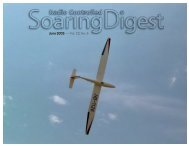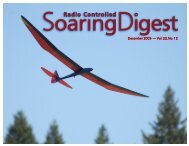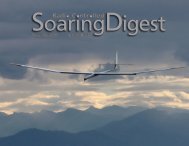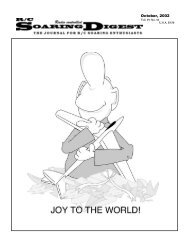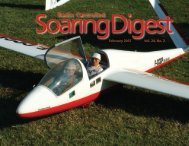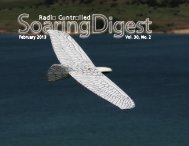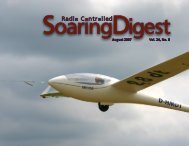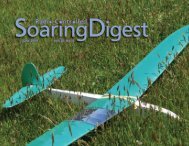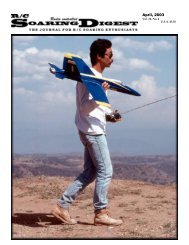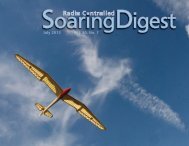August 2006 Vol. 23, No. 8 – R/C - RCSoaring.com
August 2006 Vol. 23, No. 8 – R/C - RCSoaring.com
August 2006 Vol. 23, No. 8 – R/C - RCSoaring.com
You also want an ePaper? Increase the reach of your titles
YUMPU automatically turns print PDFs into web optimized ePapers that Google loves.
Left: Adam helps Dan Neelands tune his thermal flying. It’s often beneficial to turn with rudder only.<br />
Above: James Hohensee practices his launching technique.<br />
The tail surfaces are solid balsa, milled<br />
from well-chosen sheet stock. After<br />
finishing, epoxy is rubbed in to both seal<br />
the grain and strengthen the structure.<br />
When designing control surfaces, it<br />
should be kept in mind that aileron flutter<br />
at the wing tip is somewhat <strong>com</strong>mon<br />
during launch. One way of reducing this<br />
tendency is to set the aileron end back<br />
from the wing tip to keep it out of the<br />
vortex.<br />
Control horns are all G10 printed circuit<br />
board. These have proven to be quite<br />
strong, yet easy to fabricate.<br />
Phil and Adam both use 1/3AA NiMH<br />
receiver battery packs of 300 mAh<br />
capacity.<br />
The MPI MX-30 servos are no longer<br />
available, so most pilots are now using the<br />
MX-47.<br />
The decalage (angle of the wing relative to<br />
the horizontal stabilizer) should be set for<br />
one degree. This is to assure some recovery<br />
capability following an upset.<br />
At the field, the first thing to do is perform<br />
a battery test. Adam has a very small LED<br />
unit which plugs into the switch/charging<br />
jack. Next, wiggle everything. And before<br />
giving that first discus launch, do a hand<br />
toss.<br />
Always launch flat and with a full 360<br />
degree rotation. Launching “up” breaks<br />
wings as the outside tip hits the ground!<br />
Keep the speed up during landing. This<br />
keeps the air moving over the surfaces,<br />
providing better control during this critical<br />
period.<br />
A lot of questions were asked during the<br />
clinic. One which garnered quite a bit of<br />
interest inquired about flying with a<br />
rearward CG. Phil’s response began by<br />
explaining the term “rearward CG.”<br />
Simply, you need to know where the CG is<br />
in relation to the aircraft quarter chord<br />
point on the MAC, including both the<br />
wing and stabilizer area when <strong>com</strong>puting<br />
the MAC. You never want the CG to get<br />
behind the MAC. Moving the CG rearward<br />
makes the aircraft a better indicator of lift<br />
and increases its efficiency, but at the<br />
expense of increased elevator sensitivity.<br />
<strong>August</strong> <strong>2006</strong> 51




